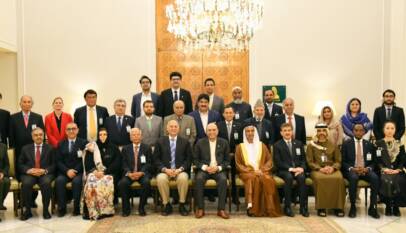Operations at Gwadar port started, Pakistan starts reaping fruits of CPEC’s connectivity
CPEC is the flagship project of the Belt and Road Initiative (BRI) AND Gwadar port is considered as a centerpiece of CPEC. Pakistan’s dream of starting international activity at this port is finally being materialized. Last week, a ship carrying 200 tonnes of fish in refrigerated containers arrived from international waters for onward shipment to China. Similarly, in June, the first bulk-cargo ship “MV Manet” carrying wheat and urea had reached Gwadar, under Pakistan-Afghanistan Transit Trade Agreement. The deep seaport of Gwadar will open new avenues of connectivity in the whole region.
Being a flagship project of China-Pakistan Economic Corridor (CPEC), Gwadar deep seaport is poised to play a greater role in regional and global trade. Finally, operations have kick- started at the port with the arrival of a ship carrying 200 tonnes of fish in refrigerated containers, from international waters for onward shipment to China. Earlier in June, first bulk-cargo ship “MV Manet” carrying wheat and urea had reached Gwadar, under Pakistan-Afghanistan Transit Trade Agreement. These developments clearly reflect confidence of international business community and shipping lines in the economic potential of the Gwadar port.
National strategy is the pivot of Gwadar port. In the times of British India, Gwadar was part of the state of Qalat. When Khan of Qalat married his daughter to Oman royal family, he gave Gwadar as a gift to his son-in-law or to his daughter. Later in 1954 Ayub Khan, the President of Pakistan, engaged the United States Geological Survey (USGS) that discovered the coastline of Gwadar to be a natural and suitable site for a new deep sea port. This finding coupled the rising demand of the residents of Gwadar to join Pakistan motivated the government to negotiate a deal with Oman. So, Gwadar became formally a part of Pakistan on December 08, 1958 after Pakistan paid the negotiated price of US$ 5.5 million.
Situated at the mouth of Persian Gulf, Strait of Hormuz, the deep sea Gwadar port with its warm waters has very strategic location. It is 460 km west of Karachi, 75 km east of Iran and 380 km northeast Oman. During the period from 1988-1992, a small port was constructed. After inauguration by General Musharraf in 2007, the port remained under Port Singapore Authority (PSA) till 2012. But, the same was handed over to China Overseas Port Holding Company (COPHC) in 2013.Since then, the rapid developments at Gwadar port has made it operational for regular shipments.
Gwadar port has immense strategic and economic significance for Pakistan. After Karachi and Qasim ports, Gwadar is the third port of Pakistan. For being located at the cross-junction of international sea shipping oil trade routes, Gwadar has potential to become an international trade hub for Pakistan. The port would conveniently connect three regions of Central Asia, South Asia and Middle East.
This regional connectivity would bring minerals, hydrocarbons, oil and gas resources of Central Asian Republics (CARs) in access for trade. Besides promotion of tourism, the port is attracting foreign investment. It is estimated that CPEC would generate transit revenue of US$ 70 billion per annum through Gwadar port. Special Economic Zones would create huge opportunities of employment. Consequently, the increased trade and commerce activities, particularly in Baluchistan province, would usher in an era of economic prosperity of Pakistan. Moreover, the port adds to the strategic leverage of Pakistan, as it would assist Pakistan to monitor the Sea Lines Communications (SLOCs) originating from the Persian Gulf and the Strait of Hormuz. Then, the oil sea routes and trade links of South Asia, Central Asia, Africa and Middle East would also be in control.
Being the largest part of the globe, Asia comprises a number of landlocked countries whose access to sea via their own land routes is very expensive. Such countries look for the shortest possible routes to carry out cheaper international trade. As we know, eastern seaport Shanghai in China is 4500km from Kashgar while Gwadar port is barely 28 km from Kashgar. Therefore, through CPEC China stands connected to the nearest Gwadar port.
It has also provided effective accessibility to the landlocked Afghanistan and Central Asia for marine trade. Alternate route of Gwadar port has afforded strategic advantage to China in situations of any blockade of Chinese trade in the Strait of Malacca. Then, 60% Chinese oil imports are from the Middle East and the opening of Gowarder port reduces the marine distance from 16000 km to 5000 km and the duration from 45 days to 10 days.
Finally, it may be concluded that Gwadar port is destined to play a vital role in regional connectivity, growth of global trade and commerce, and the economic prosperity of Pakistan. Security challenges if any must be coped with effectively.
It is also baseless to talk about any rivalry between Gwadar and Chahbahar ports. In fact, Gwadar port complements to Chahbahar for having capacity to handle heavy shipments due its deep sea. Iran itself intends to join CPEC.
The writer is Country Manager of a Pakistani bank in Kazakhstan, with interest in Central Asian studies. He can be reached out at rafeeq_kz@yahoo.com.
Chinese envoy Zhao Shiren urges students to uphold integrity and strengthen China-Pakistan ties
LAHORE:The Consul Generals from several countries and other distinguished guests attended …











